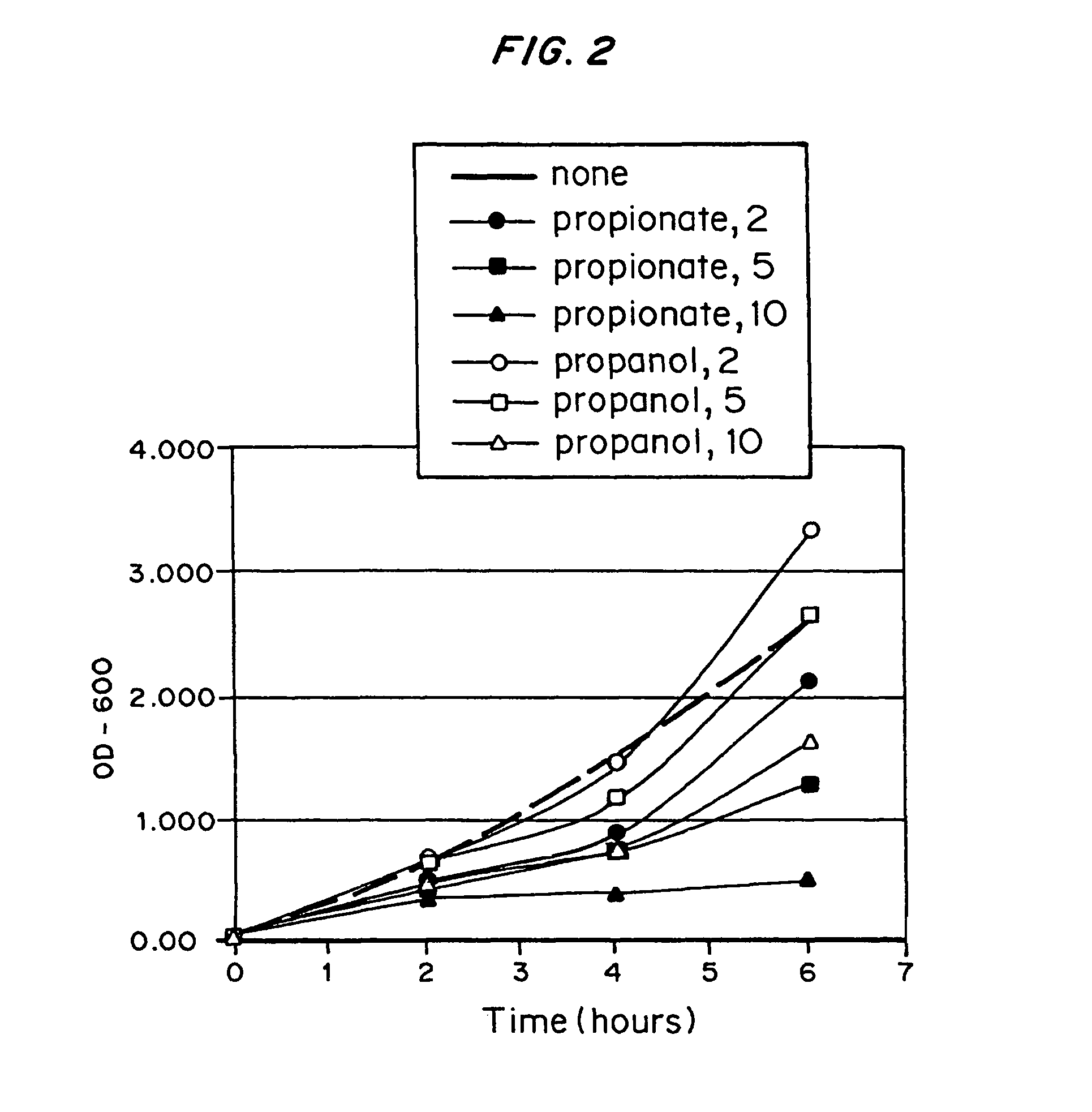Polyhydroxyalkanoate production by coenzyme A-dependent aldehyde dehydrogenase pathways
a technology of coenzyme a and aldehyde dehydrogenase, which is applied in the field of making 2hydroxyacid monomers and the resulting polyhydroxyalkanoate polymers, can solve the problems of reducing the growth rate and polymer production rate, affecting the production efficiency of phas, so as to achieve the effect of rapid recovery
- Summary
- Abstract
- Description
- Claims
- Application Information
AI Technical Summary
Problems solved by technology
Method used
Image
Examples
example 1
Isolation and Identification of CoA-dependent Aldehyde Dehydrogenase
Because of its homology to the gene encoding the CoA-dependent aldehyde dehydrogenase component of the multifunctional alcohol dehydrogenase protein (AdhE) of E. coli, the eutE gene was amplified from the E. coli genome using the following oligonucleotide primers:
(SEQ ID NO: 1)5′-GGT GGT ACC TTA AGA GGA GGT TTT TAT GAA TCA ACAGGA TAT TGA ACA-3′(eutE 5′Acc65I).(SEQ ID NO: 2)5′-GGT GCG GCC GCT TAA ACA ATG CGA AAC GCA TCG-3′(eutE 3′NotI).
The PCR product was digested with Acc 65I and NotI and ligated to pSE380 (Invitrogen; La Jolla, Calif.) that had been cut with the same enzymes. The resulting plasmid, which contained the eutE gene under control of the IPTG-inducible trc promoter, was designated pMS35.
E. coli DH5a propagating either pMS35 or pTrcN (the same as pTrc99a, Pharmacia; Uppsala, Sweden except with the NotI restriction site eliminated) was grown overnight in 2 mL Luria-Bertani (LB) broth (Difco; Detroit, Mich....
example 2
Difference in Toxicity Between Propionate and 1-propanol
E. coli strain MBX1335 was grown in the presence of propionate or 1-propanol to compare the inhibition of growth rate effected by these compounds. One important reason for finding alternatives to propionate feeding is that propionate slows the rate of growth and metabolism in fermentations.
MBX1335 was grown overnight in LB medium supplemented with 25 μg / mL chloramphenicol. This culture was used to inoculate several 3-mL cultures of minimal medium supplemented with varying concentrations of propionate or 1-propanol. The base medium in these 3-mL cultures contained, per liter: 5 g glucose; 1 mmol MgSO4; 10 mg thiamine; 25.5 mmol Na2HPO4; 33.3 mmol K2HPO4; 27.2 mmol KH2PO4; 2.78 mg FeSO4.7H2O; 1.98 mg MnCl2.4H2O; 2.81 mg CoSO4.7H2O; 0.17 mg CuCl2.2H2O; 1.67 mg CaCl2.2H2O; 0.29 mg ZnSO4.7H2O; 0.1 g casein hydrolysate; and 25 μg chloramphenicol. This medium also contained either sodium propionate (pH 7), 1-propanol, or no added subs...
example 3
PHBV Production from Glucose and 1-propanol in Wild-type and Alcohol Dehydrogenase-deregulated Strains
The Escherichia coli strains DC675 and DC698 are described in Clark and Rod, J. Mol. Evol. 25:151-158 (1987). Strain DC698 is a regulatory mutant which produces alcohol dehydrogenase (the product of the adhE gene) constitutively. Strain DC675, from which DC698 was derived, only produces alcohol dehydrogenase under anaerobic conditions, as is generally true for wild-type E. coli strains. Each of these strains was transduced with a bacteriophage P1 lysate of E. coli strain MBX1335, which stably expresses PHB synthesis genes from the chromosome.
A bacteriophage P1 lysate of MBX1335 was made as follows: MBX1335 was grown to an optical density (600 nm) of about 0.2 in 3 mL Luria broth (LB). Calcium chloride was added to 10 mM, and 30 μL of a P1 lysate made previously was added. The mixture was incubated at 37° C. for 4 h. After the incubation, 50 μL of chloroform was added, and the mixtur...
PUM
| Property | Measurement | Unit |
|---|---|---|
| mol % | aaaaa | aaaaa |
| thickness | aaaaa | aaaaa |
| optical density | aaaaa | aaaaa |
Abstract
Description
Claims
Application Information
 Login to View More
Login to View More - R&D
- Intellectual Property
- Life Sciences
- Materials
- Tech Scout
- Unparalleled Data Quality
- Higher Quality Content
- 60% Fewer Hallucinations
Browse by: Latest US Patents, China's latest patents, Technical Efficacy Thesaurus, Application Domain, Technology Topic, Popular Technical Reports.
© 2025 PatSnap. All rights reserved.Legal|Privacy policy|Modern Slavery Act Transparency Statement|Sitemap|About US| Contact US: help@patsnap.com


